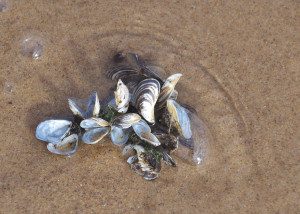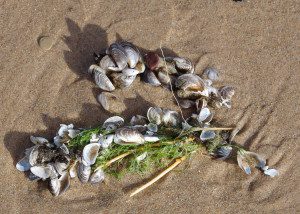Howdy, BugFans,
When the BugLady started researching zebra mussels (which were originally going to solo here), she was reminded that the story of this non-native, invasive mussel is inextricably entwined with that of an equally-alien and equally-invasive mussel, the quagga mussel – and also that we are, as a species, appallingly slow learners.
Zebra and quagga mussels are in the Phylum Mollusca, a diverse bunch that includes snails and slugs, limpets, clams, scallops, squid, octopi, and cuttlefish; within the Mollusks, they’re in the order Bivalva, and in the family Dreissenidae.
Zebra mussels (Dreissena polymorpha) and Quagga mussels (Dreissena bugensis) have traveled far from their native haunts, the Caspian Sea drainage of western Russia, but they have settled nicely into their new homes, the Great Lakes and a number of inland lakes and rivers – hitchhiking on boats, boots, bait buckets, and on the feet of waterfowl. Zebra mussels were first identified in the US in 1988, in Lake St. Clair, just east of Detroit, and they reached Wisconsin by 1992. In 2010, they were found in 130 Wisconsin lakes and rivers. The first North American quagga mussel was found in 1989, but it wasn’t positively identified until 1991. Here are some animated maps of the mussels’ spread between 1986 and 2015 (click on the “real-time maps”): https://nas.er.usgs.gov/taxgroup/mollusks/zebramussel/ (the BugLady loves animated maps), and graphics of their spread in the Lake Michigan basin alone: http://sanctuaries.noaa.gov/science/condition/tbnms/images/fig36_lg.jpg. The two mussels are now found in 29 states, and the National Wildlife Federation website estimates that the Great Lakes alone are home to 10 trillion (with a “T”) zebra and quagga mussels.
Did they hoof it over here on their own? They did not; like most of us, they came over on the boat. They undoubtedly arrived in the Great Lakes in the ballast water of ships that ply international waters, as have a rogue’s gallery of hardy gatecrashers (more than 180 species, so far), and a number of North American organisms have been toted to Europe in the same fashion.
Here’s the physics of it: while they’re in their home ports, European vessels take water (plus whatever’s swimming in that water) into tanks built on the inside of the ship’s hull, and this “ballast water” helps keep the ship upright. A ship carrying a small cargo needs lots of ballast; as it loads more cargo, it discharges ballast water (plus whatever’s swimming in it) https://en.wikipedia.org/wiki/Ballast_water_discharge_and_the_environment#/media/File:Ballast_water_en.svg. Ocean-going ships routinely enter the Great Lakes via the St. Lawrence Seaway, and equally routinely, emptied their ballast water into the Great Lakes. In 1993, a (difficult-to-enforce) law was passed that required incoming ships to replace their home-grown ballast water with ocean water before entering the Seaway,
In 2011, New York State, gatekeeper for the St Lawrence Seaway, proposed stiff, new regulations about ballast water management/treatment. Three Midwestern governors pushed back, citing concerns about job loss (although some innovative alternative transport was suggested at the time).
Zebra and quagga mussels turned out to be plenty adaptable – although they originated in salt/brackish water, they quickly adjusted to fresh. They are bottom dwellers that live in clusters in great, huge, astronomical numbers on the floors of lakes (at one site in Arizona, quagga mussels number 35,000 per square meter).
When quagga mussels arrived, they out-competed the zebra mussels. Although their life histories are similar, the two mussels prefer somewhat different habitats. Zebra mussels like water depths of 6 to 30 feet, and quaggas can live as deep as 400 feet, so zebra mussels grow closer to shore, and quaggas thrive through the deep basins of the Great Lakes. Quaggas necessarily have a much wider temperature tolerance. Both species eat all day, but quaggas continue feeding during the winter, when zebra mussels are dormant. Pictures of the two may be found at: https://nas.er.usgs.gov/queries/factsheet.aspx?speciesid=5. The BugLady’s photos show them as most people experience them – as “empties,” cast up on the beach.
Mussels are “filter feeders,” which means that they suck water in through a siphon and run it over their gills. Food particles, zooplankton, phytoplankton, and nutrients (and pollutants) are strained out of the water by cilia in the gills and are moved to the clam’s mouth, and the water is expelled through a second siphon. Wastes are released in mucous-covered packets called pseudofeces (vocabulary word of the day). An inch-long zebra mussel can filter a liter of water a day. One liter per day x Astronomical numbers of mussels = large bodies of very clean water.
At first, some people were thrilled – “Yay, the lake is clean again” shouted the headlines. Cities around Lake Erie had been battling pollution in the form of algal blooms due to excessive nutrients (fertilizer) in the water. In short order, you could see the bottom of the lake again (it’s called “nutrient bioextraction,” and it can be a useful tool in controlled situations where the bivalves are removed when they’re finished eating and processed into animal food or, ironically, fertilizer).
However, the water was crystal clear because there were so few nutrients left in it, and native species that depended on the food in those liters of water were out of luck. It was an attack on the base of the food chain/web. Zooplankton feed on phytoplankton and are fed upon by larger animals, including tiny fish, which, in turn, feed bigger fish and a variety of other vertebrates. But, nutrient robbing is not the only problem with these mussels.
- Quaggas eat algae, but they’re picky, and non-toxic algae are their favorites. What’s left after they feed is higher concentrations of the more troublesome algae. Light is able to penetrate deeper into the nice, clean water, opening the door for more algal blooms. Decaying algae, some carrying harmful bacteria, wash up on the shore.
- The clear water can allow thick growths of other aquatic plants, too, fertilized by nutrient-rich mussel poop. Dense aquatic vegetation discourages swimming, fishing, and boating.
- Our native shellfish are indicators of the health of their environment. The invasive mussels turn lake beds hard and lumpy, with wall-to-wall shells, making it hard for native bivalves to find favorable habitat. To add insult to injury, zebra mussels will piggyback on native mussels, hindering their feeding and ultimately smothering them. Great picture at: http://www.startribune.com/mussel-bound-lakes-could-imperil-birds/133021828/.
- Old zebra and quagga mussel shells wash up on shore, often in sharp fragments, problematic for barefoot beach-goers.
- Zebra mussels overgrow anything that stands still long enough, especially pilings and other underwater surfaces, and they clog utility water intake/cooling pipes, requiring costly fixes. Researchers in a few northern lakes have observed an odd (and one-sided) association – zebra mussels growing on the backs of clubtail dragonfly naiads (immature clubtails may live underwater for several years, giving mussels plenty of time to gain a foothold). Their exoskeletons are effectively glued shut by mussel filaments on the thorax, where the exoskeleton normally splits to release the adult dragonfly, so naiads crawl up on shore and die there, unable to emerge.
- As they feed, quagga and zebra mussels accumulate toxins, with some pollutants occurring in their tissues (and their pseudofeces) in concentrations measuring many thousands of times higher than in the surrounding water. Those toxins (including Clostridium botulinum) get passed up the food chain in a process called biomagnification.
- A mass of pseudofeces on the lake’s floor requires oxygen in order to decompose.
Lake Superior has mostly avoided this mess, probably due to a combination of its much colder temperatures, lower levels of nutrients in the water, and its water chemistry – very little calcium for growing strong shells.
Mussel reproduction is external and chancy. Males and females release their bodily fluids into the water, nature takes its course (aided by water currents and propinquity), and fertilized eggs hatch into a life stage called veligers. An adult female can produce as many as a million eggs annually, and her life span is three to five years, but the attrition rate for eggs and veligers is huge (they’re even eaten by filter-feeding adults). Mom and Dad may be stuck in one spot, but their offspring are, temporarily, free-swimming, and currents can spread them great distances. Veligers swim and feed for four or five weeks before they must attach, and they mature by their first birthday.
What slows these critters down?
- Fish, like yellow perch and redeye sunfish, and waterfowl, especially diving ducks like goldeneye and scaup, have learned to love the invasive mussels (98% of a Lesser Scaup’s diet is zebra mussels). Kudos also go to the alien, quagga-eating round gobi fish. Alien species that become invasive do so because they have left their native predators behind. In this case, the predator caught up with the mussel, but, alas, this aggressive fish damages native fish populations, too.
- A patented bacterium called Zequanox targets these two mussel species only and has a 90% mortality rate, but is far too expensive to apply to a Great Lake.
- Unusually warm water – In 2001, the water temperature in parts of the Upper Mississippi reached 89 degrees F, and masses of zebra mussels died.
Good news-Bad news: For zebra mussels in the Great Lakes, the show is over, but they’ve simply been replaced by quaggas, and scientists doubt that the Great Lakes will ever return to their pre-alien-mussel state. At this point, Lake Michigan (the 6th-largest freshwater lake in the world) is essentially a man-made ecosystem that’s being managed as a fishery, because the base of the food chain/web is so messed up. Excellent article at: http://archive.jsonline.com/news/wisconsin/how-invasive-species-changed-the-great-lakes-forever-b99297128z1-267010971.html.
For those people whose attitude toward alien species is “Get over it – A species is a species! New species = more biodiversity,” the BugLady has one word. “Seriously???”
For all your invasive species needs, remember our own Southeastern Wisconsin Invasive Species Consortium (SEWISC), https://sewisc.org/, a wealth of information about invasive species already in the state and on the horizon.
Be assured that the BugLady did not use any of the information presented in the article about “Zebra Muscles” (ain’t Spellcheck grand?).
Kate Redmond, The BugLady
Bug of the Week archives:
http://www4.uwm.edu/


